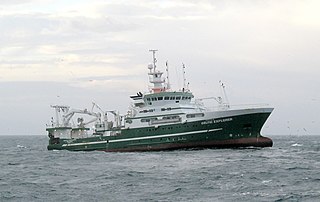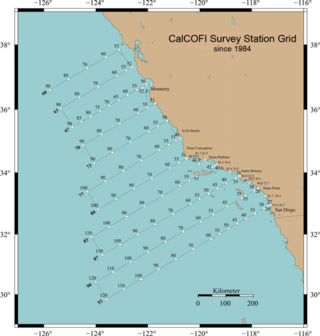
Trolling is a method of fishing where one or more fishing lines, baited with lures or bait fish, are drawn through the water. This may be behind a moving boat, or by slowly winding the line in when fishing from a static position, or even sweeping the line from side-to-side, e.g. when fishing from a jetty. Trolling is used to catch pelagic fish such as salmon, mackerel and kingfish.

Trawling is an industrial method of fishing that involves pulling a fishing net, that is heavily weighted to keep it on the seafloor, through the water behind one or more boats. The net used for trawling is called a trawl. This principle requires netting bags which are towed through water to catch different species of fishes or sometimes targeted species. Trawls are often called towed gear or dragged gear.

Bycatch, in the fishing industry, is a fish or other marine species that is caught unintentionally while fishing for specific species or sizes of wildlife. Bycatch is either the wrong species, the wrong sex, or is undersized or juveniles of the target species. The term "bycatch" is also sometimes used for untargeted catch in other forms of animal harvesting or collecting. Non-marine species that are caught but regarded as generally "undesirable" are referred to as rough fish or coarse fish.

A fishing trawler is a commercial fishing vessel designed to operate fishing trawls. Trawling is a method of fishing that involves actively dragging or pulling a trawl through the water behind one or more trawlers. Trawls are fishing nets that are pulled along the bottom of the sea or in midwater at a specified depth. A trawler may also operate two or more trawl nets simultaneously.

Gillnetting is a fishing method that uses gillnets: vertical panels of netting that hang from a line with regularly spaced floaters that hold the line on the surface of the water. The floats are sometimes called "corks" and the line with corks is generally referred to as a "cork line." The line along the bottom of the panels is generally weighted. Traditionally this line has been weighted with lead and may be referred to as "lead line." A gillnet is normally set in a straight line. Gillnets can be characterized by mesh size, as well as colour and type of filament from which they are made. Fish may be caught by gillnets in three ways:
- Wedged – held by the mesh around the body.
- Gilled – held by mesh slipping behind the opercula.
- Tangled – held by teeth, spines, maxillaries, or other protrusions without the body penetrating the mesh.

Bottom trawling is trawling along the seafloor. It is also referred to as "dragging". The scientific community divides bottom trawling into benthic trawling and demersal trawling. Benthic trawling is towing a net at the very bottom of the ocean and demersal trawling is towing a net just above the benthic zone. Bottom trawling can be contrasted with midwater trawling, where a net is towed higher in the water column. Midwater trawling catches pelagic fish such as anchovies and mackerel, whereas bottom trawling targets both bottom-living fish (groundfish) and semi-pelagic species such as cod, squid, shrimp, and rockfish.

A turtle excluder device (TED) is a specialized device that allows a captured sea turtle to escape when caught in a fisherman's net.

Pair trawling is a fishing activity carried out by two boats, with one towing each warp. As the mouth of the net is kept open by the lateral pull of the individual vessels, otter boards are not required. With the towing power of two boats and no otter boards, a larger net may be worked than would otherwise be possible, or alternatively, the two boats can share increased fuel efficiency.
The Scottish east coast fishery has been in existence for more than a thousand years, spanning the Viking Age right up to the present day.

A fishing vessel is a boat or ship used to catch fish and other valuable nektonic aquatic animals in the sea, lake or river. Humans have used different kinds of surface vessels in commercial, artisanal and recreational fishing.

CalCOFI is a multi-agency partnership formed in 1949 to investigate the collapse of the sardine population off California. The organization's members are from NOAA Fisheries Service, Scripps Institution of Oceanography, and California Department of Fish and Wildlife. The scope of this research has evolved into the study of marine ecosystems off California and the management of its fisheries resources. In 2004, the CalCOFI survey area became one of 26 Long Term Ecological Research Network (LTER) research sites. This time-series of oceanographic and fisheries data allows scientists to assess the human impact and effects of climate change on the coastal ocean ecosystem. CalCOFI hydrographic and biological data, publications, and web information are distributed for use without restriction under the terms of the GNU Free Documentation License.

The environmental impact of fishing includes issues such as the availability of fish, overfishing, fisheries, and fisheries management; as well as the impact of industrial fishing on other elements of the environment, such as bycatch. These issues are part of marine conservation, and are addressed in fisheries science programs. According to a 2019 FAO report, global production of fish, crustaceans, molluscs and other aquatic animals has continued to grow and reached 172.6 million tonnes in 2017, with an increase of 4.1 percent compared with 2016. There is a growing gap between the supply of fish and demand, due in part to world population growth.

A factory ship, also known as a fish processing vessel, is a large ocean-going vessel with extensive on-board facilities for processing and freezing caught fish or whales. Modern factory ships are automated and enlarged versions of the earlier whalers and their use for fishing has grown dramatically. Some factory ships are equipped to serve as a mother ship.

Fishing techniques are methods for catching fish. The term may also be applied to methods for catching other aquatic animals such as molluscs and edible marine invertebrates.

A fishing dredge, also known as a scallop dredge or oyster dredge, is a kind of dredge which is towed along the bottom of the sea by a fishing boat in order to collect a targeted edible bottom-dwelling species. The gear is used to fish for scallops, oysters and other species of clams, crabs, and sea cucumber. The dredge is then winched up into the boat and emptied. Dredges are also used in connection with the work of the naturalist in marine biology, notably on the Challenger Expedition.
This page is a list of fishing topics.
This is a glossary of terms used in fisheries, fisheries management and fisheries science.
Destructive fishing practices are fishing practices which easily result in irreversible damage to habitats and the sustainability of the fishery ecosystems. Such damages can be caused by direct physical destruction of the underwater landform and vegetation, overfishing indiscriminate killing/maiming of aquatic life, disruption of vital reproductive cycles, and lingering water pollution.

The Cape horse mackerel is a mackerel-like species in the family Carangidae. It is a pelagic species of the south eastern Atlantic Ocean which is a target of fisheries, mainly as bycatch.

Electric pulse fishing is a fishing technique sometimes used in trawl fisheries which produces a limited electric field above the seabed to catch fish. The pulse trawl gear consists of a number of electrodes, attached to the gear in the tow direction, that emit short electric pulses. The electrodes replace the tickler chains that are used in traditional beam trawl fishery. The pulse trawl fishery is mainly aimed at flatfish like sole, with by-catch plaice. In addition, the pulse trawl gear is applied in shrimp fisheries on a limited scale. Technically, the use of electricity to catch fish is prohibited in European waters. However, the European Union is able to provide exemptions to this rule since 2007. These exemptions are now mainly used by Dutch and British trawlers in the North Sea.


















